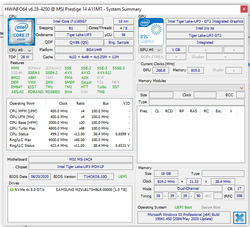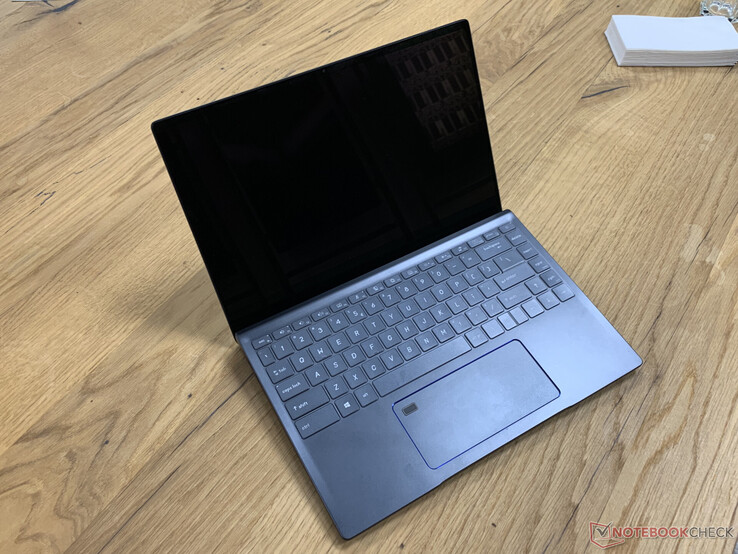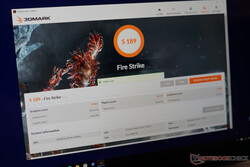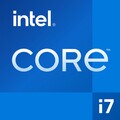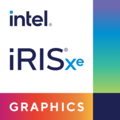Recensione dell'Intel Core i7-1185G7 - Primi Benchmarks Tiger Lake
Sistma di Test
Abbiamo testato un "Intel Reference Design System", che è stato costruito per Intel. Si basa sul notebook barebone MSI Prestige 14 (recensito con la Comet Lake), che non sarà disponibile per la vendita al dettaglio. Si tratta di un notebook relativamente sottile di 14", che si solleva leggermente quando si apre lo schermo e aspira l'aria dal fondo. Il rumore della ventola è stato moderato durante i nostri benchmarks. Il telaio in alluminio si è riscaldato abbastanza, ma non è stato troppo male. Purtroppo non ci è stato permesso di pubblicare alcuna foto degli interni.
Abbiamo potuto selezionare tre diversi livelli di prestazioni per i nostri benchmarks:
- Batteria migliore: 15 Watt PL1 (carico sostenuto, HWInfo: 14.8 W duarnte Blender) e 54W PL2 (28s carico di picco, HWInfo 54.5W durante Blender)
- Prestazioni migliori: 28 Watt PL1 (carico sostenuto, HWInfo: 27.9 W durante Blender) e 54W PL2 (28s carico di picco, HWInfo: 54 W durante Blender)
- Prestazioni migliori: 28 Watt o 36 Watt con Dynamic Tuning (carico sostenuto, HWInfo 35.3W durante Blender) e 54 W PL2 (HWInfo 54.7 W durante Blender)
Intel ha raccomandato la modalità "Better Performance", perché probabilmente sarà la più rappresentativa per le unità di produzione. Abbiamo quindi eseguito la maggior parte dei nostri test con 28W e abbiamo controllato solo i singoli test con 15W e 36W (Dynamic Tuning). Il Dynamic Tuning mantiene i 36W PL1 fino a quando le temperature interne e le temperature "superficiale" non diventano troppo alte, altrimenti scenderà a 28W.
I nostri Top 10
» Top 10 Portatili Multimedia
» Top 10 Portatili Gaming
» Top 10 Portatili Gaming Leggeri
» Top 10 Portatili da Ufficio e Business economici
» Top 10 Portatili Premium da Ufficio/Business
» Top 10 Portatili sotto i 300 Euro
» Top 10 Portatili sotto i 500 Euro
» Top 10 dei Portatili Workstation
» Top 10 Subnotebooks
» Top 10 Ultrabooks
» Top 10 Convertibili
» Top 10 Tablets
» Top 10 Tablets Windows
» Top 10 Smartphones
Prestazioni CPU - Ice Lake con Turbo
Il Core i7-1185G7 che abbiamo testato è il modello di fascia alta per il lancio della generazione Tiger Lake U e offre quattro cores di processore (micro architettura Willow Cove), che possono funzionare fino a 4,8 GHz. Ciò significa che il clock di picco è molto più alto rispetto a Ice Lake e dovrebbe portare a prestazioni più elevate del singolo core. Rispetto agli attuali modelli di punta di AMD, Intel utilizza ancora quattro cores e preferisce utilizzare il chip die per un'unità grafica più potente, oltre al Wi-Fi (parzialmente) integrato e al Thunderbolt 4.
Se guardiamo solo alle prestazioni del processore, c'è un vantaggio impressionante rispetto al vecchio Core i7-1065G7 (come nel Dell XPS 13 9300, per esempio). Rispetto ai veloci processori AMD Renoir, il sistema di test si trova tra i due chip a 8 cores Ryzen 7 4700U e 4800U - impressionante. Le elevate prestazioni del single-core fanno davvero la differenza in questo caso. L'i7-1185G7 può battere tutti i rivali nei test Single-Core Cinebench. Anche un desktop Core i9-10900K o Ryzen 7 3800XT sono leggermente più lenti. Se si guarda ai benchmarks multi-core, come il test Blender, che richiede molto tempo, i chip 8-cores di AMD hanno ancora un grande vantaggio. Tuttavia, Intel può colmare il divario rispetto alla CPU Ryzen 5 4500U 6-cores, che mostra ancora una volta il potenziale di prestazioni dei quattro cores di Tiger Lake.
Rispetto ai chip Comet lake-U e alla serie H di Intel, Tiger Lake si comporta ancora una volta molto bene. La serie U è chiaramente battuta - nonostante i 6 cores (che difficilmente ripagano a causa della bassa dotazione di TDP). La serie H con 8 cores vince ancora nei test multi-core, ma i chip quad-core più piccoli come il Core i5-10300H vengono battuti.
| Performance rating - Percent | |
| Media Intel Core i9-10980HK | |
| Media Intel Core i7-10875H | |
| Lenovo Yoga Slim 7-14ARE | |
| Intel Reference Design Laptop 35W Dynamic Tuning -4! | |
| Media Intel Core i7-10750H | |
| Intel Reference Design Laptop 28W | |
| Media AMD Ryzen 7 4700U | |
| Media Intel Core i7-1165G7 | |
| Xiaomi RedmiBook 16 R5 | |
| Media Intel Core i5-10300H | |
| Media AMD Ryzen 5 4500U | |
| Intel Reference Design Laptop 15W | |
| Media Intel Core i7-10710U | |
| Dell XPS 13 9300 4K UHD | |
| Media Intel Core i7-10810U | |
| Media Intel Core i7-1065G7 | |
| Media AMD Ryzen 3 4300U | |
| Blender - v2.79 BMW27 CPU | |
| Media AMD Ryzen 3 4300U (868 - 907, n=2) | |
| Media Intel Core i7-1065G7 (675 - 1650, n=23) | |
| Intel Reference Design Laptop 15W | |
| Media Intel Core i7-10810U (571 - 875, n=5) | |
| Dell XPS 13 9300 4K UHD | |
| Media Intel Core i7-10710U (468 - 892, n=4) | |
| Media Intel Core i7-1165G7 (468 - 1138, n=80) | |
| Media AMD Ryzen 5 4500U (533 - 748, n=11) | |
| Intel Reference Design Laptop 28W | |
| Xiaomi RedmiBook 16 R5 | |
| Media Intel Core i5-10300H (479 - 555, n=14) | |
| Intel Reference Design Laptop 35W Dynamic Tuning | |
| Media AMD Ryzen 7 4700U (407 - 537, n=8) | |
| Media Intel Core i7-10750H (322 - 587, n=43) | |
| Media Intel Core i7-10875H (259 - 535, n=30) | |
| Lenovo Yoga Slim 7-14ARE | |
| Media Intel Core i9-10980HK (239 - 299, n=13) | |
* ... Meglio usare valori piccoli
Le prestazioni sostenute sono stabili sul portatile di riferimento di Intel, e non vediamo il solito calo dopo che il benchmark iniziale funziona in modalità 28W o 15W.
Come abbiamo già riferito durante il lancio, la Tiger Lake non utilizza più limiti fissi di TDP, ma i produttori possono scegliere tra 15 e 28W (a seconda della soluzione di raffreddamento). Compreso il Dynamic Tuning, la CPU può anche consumare fino a 36W per periodi più lunghi. I nostri benchmarks mostrano chiaramente che queste impostazioni TDP hanno un effetto massiccio sulle prestazioni. Le prestazioni single-core non ne risentono molto, perché il limite dei 15W è già sufficiente per i clock elevati, ma le prestazioni della CPU diminuiranno rispettivamente del 27% o del 31% rispetto all'impostazione massima. Ciò significa che ci saranno ancora notevoli differenze di prestazioni tra un notebook e l'altro. Non si può semplicemente guardare il nome del modello come i7-1185G7 per conoscere le prestazioni che si otterranno.
| Blender - v2.79 BMW27 CPU | |
| Media AMD Ryzen 3 4300U (868 - 907, n=2) | |
| Intel Reference Design Laptop 15W | |
| Media Intel Core i7-1165G7 (468 - 1138, n=80) | |
| Media AMD Ryzen 5 4500U (533 - 748, n=11) | |
| Intel Reference Design Laptop 28W | |
| Xiaomi RedmiBook 16 R5 | |
| Media Intel Core i5-10300H (479 - 555, n=14) | |
| Intel Reference Design Laptop 35W Dynamic Tuning | |
| Media AMD Ryzen 7 4700U (407 - 537, n=8) | |
| Media AMD Ryzen 5 4600U (n=1) | |
| Media AMD Ryzen 7 4800U (322 - 374, n=3) | |
| Media Intel Core i7-10875H (259 - 535, n=30) | |
| Lenovo Yoga Slim 7-14ARE | |
| Media Intel Core i9-10980HK (239 - 299, n=13) | |
* ... Meglio usare valori piccoli
Prestazioni con le Applicazioni - PCMark 10
Usiamo ancora il normale PCMark 10 per le prestazioni con le applicazioni, che includono software free come LibreOffice, GIMP, Firefox e Chromium. Grazie al veloce SSD PM981a da 1TB di Samsung, l'MSI barebone con Tiger Lake ottime prestazioni. Il sistema resta solo un po' indietro nella parte di Content Creation, ma gli altri due sub test producono punteggi ancora più alti rispetto ai veloci notebook gaming con CPU CML-H a 8 cores (i9-10980HK). Il punteggio complessivo è più basso sul sistema i7-1185G7, ma è nettamente superiore al Lenovo Yoga Slim 7 con CPU Ryzen 7 4800U. Il risultato è un indicatore di quanto bene i sistemi basati su Tiger Lake dovrebbero (o potrebbero, rispettivamente) gestire le attività d'ufficio e produttive.
| PCMark 10 / Score | |
| Media Intel Core i9-10980HK (5277 - 6988, n=12) | |
| Media Intel Core i7-10875H (4884 - 6739, n=24) | |
| Intel Reference Design Laptop 28W | |
| Lenovo Yoga Slim 7-14ARE | |
| Media AMD Ryzen 7 4800U (5233 - 5383, n=3) | |
| Media Intel Core i7-1165G7 (4531 - 5931, n=72) | |
| Media AMD Ryzen 7 4700U (4527 - 5307, n=8) | |
| Xiaomi RedmiBook 16 R5 | |
| Media AMD Ryzen 5 4600U (n=1) | |
| Media Intel Core i5-10300H (4077 - 5301, n=13) | |
| Media AMD Ryzen 5 4500U (4393 - 5024, n=12) | |
| Dell XPS 13 9300 4K UHD | |
| Media AMD Ryzen 3 4300U (n=1) | |
| PCMark 10 / Essentials | |
| Intel Reference Design Laptop 28W | |
| Media Intel Core i9-10980HK (9312 - 10829, n=12) | |
| Media Intel Core i7-1165G7 (8026 - 11505, n=72) | |
| Lenovo Yoga Slim 7-14ARE | |
| Media Intel Core i7-10875H (7547 - 10458, n=24) | |
| Media AMD Ryzen 7 4800U (9188 - 9637, n=3) | |
| Media AMD Ryzen 5 4600U (n=1) | |
| Dell XPS 13 9300 4K UHD | |
| Media AMD Ryzen 7 4700U (8303 - 9559, n=8) | |
| Xiaomi RedmiBook 16 R5 | |
| Media Intel Core i5-10300H (7148 - 9874, n=13) | |
| Media AMD Ryzen 5 4500U (8204 - 9124, n=11) | |
| Media AMD Ryzen 3 4300U (n=1) | |
| PCMark 10 / Productivity | |
| Intel Reference Design Laptop 28W | |
| Media Intel Core i9-10980HK (7641 - 9337, n=12) | |
| Media Intel Core i7-10875H (7534 - 9070, n=24) | |
| Media AMD Ryzen 7 4800U (7631 - 8091, n=3) | |
| Lenovo Yoga Slim 7-14ARE | |
| Media Intel Core i5-10300H (6732 - 8058, n=13) | |
| Media Intel Core i7-1165G7 (5570 - 9317, n=72) | |
| Media AMD Ryzen 7 4700U (5348 - 7945, n=8) | |
| Xiaomi RedmiBook 16 R5 | |
| Media AMD Ryzen 5 4500U (6400 - 7752, n=11) | |
| Dell XPS 13 9300 4K UHD | |
| Media AMD Ryzen 3 4300U (n=1) | |
| Media AMD Ryzen 5 4600U (n=1) | |
| PCMark 10 / Digital Content Creation | |
| Media Intel Core i9-10980HK (5177 - 10217, n=12) | |
| Media Intel Core i7-10875H (4563 - 9448, n=24) | |
| Lenovo Yoga Slim 7-14ARE | |
| Media AMD Ryzen 7 4800U (5123 - 5758, n=3) | |
| Intel Reference Design Laptop 28W | |
| Media AMD Ryzen 5 4600U (n=1) | |
| Media Intel Core i7-1165G7 (4083 - 6957, n=72) | |
| Media AMD Ryzen 7 4700U (4459 - 5495, n=8) | |
| Xiaomi RedmiBook 16 R5 | |
| Media Intel Core i5-10300H (2928 - 6003, n=13) | |
| Media AMD Ryzen 5 4500U (4189 - 4808, n=11) | |
| Media AMD Ryzen 3 4300U (n=1) | |
| Dell XPS 13 9300 4K UHD | |
Prestazioni GPU - L'architettura Xe promette prestazioni elevate
I processori Tiger Lake sono i primi chip con la nuova generazione grafica Xe. Intel lo chiama solo "Intel Iris Xe Graphics" sul nostro Core i7-1185G7, ed è supportato da 16 GB LPDDR4x-4266 di RAM in una configurazione dual-channel. Tuttavia, l'iGPU non ha una propria memoria grafica (ad eccezione delle cache). Intel pubblicizza un grande vantaggio di prestazioni rispetto alla generazione Ice Lake, quindi è un grande miglioramento dopo un lungo periodo di iGPU familiari.
La nuova GPU Xe si comporta estremamente bene nei benchmarks grafici sintetici. È alla pari con una AMD Radeon Pro 560X dedicata nell'Apple MacBook Pro 15 e le iGPU Ryzen più veloci (come la RX Vega 8 nella Ryzen 4000) sono chiaramente battute. Anche le schede grafiche mobili di Nvidia come la GeForce MX350 sono molto più lente e il punteggio è più paragonabile al nuovo MX450.
Le prestazioni di calcolo della GPU in V-Ray non sono così impressionanti, ma sono ancora alla pari con le vecchie GeForce MX250/MX330. Le GPU AMD sono più potenti in questo test.
| Basemark GPU 1.2 - 1920x1080 Vulkan Medium Offscreen | |
| Media NVIDIA GeForce MX450 (n=1) | |
| Intel Reference Design Laptop 28W | |
| Apple MacBook Pro 15 2018 (2.6 GHz, 560X) | |
| Apple MacBook Pro 15 2018 (2.6 GHz, 560X) | |
| Intel Reference Design Laptop 15W | |
| Media AMD Radeon RX Vega 8 (Ryzen 4000/5000) (68.3 - 289, n=11) | |
| Media AMD Radeon RX Vega 7 (68.3 - 289, n=11) | |
| Media Intel Iris Plus Graphics G7 (Ice Lake 64 EU) (n=1) | |
| Media AMD Radeon RX Vega 6 (Ryzen 4000/5000) (82.6 - 104.6, n=2) | |
| Xiaomi RedmiBook 16 R5 | |
| V-Ray Benchmark Next 4.10 - GPU | |
| Media NVIDIA GeForce GTX 1050 Mobile (n=1) | |
| Media AMD Radeon RX Vega 8 (Ryzen 4000/5000) (31 - 83, n=50) | |
| Lenovo Yoga Slim 7-14ARE | |
| Media AMD Radeon RX Vega 7 (14 - 70, n=48) | |
| Media AMD Radeon RX Vega 6 (Ryzen 4000/5000) (30 - 52, n=15) | |
| Intel Reference Design Laptop 35W Dynamic Tuning | |
| Media NVIDIA GeForce MX350 (33 - 41, n=10) | |
| Media NVIDIA GeForce MX450 (28 - 40, n=17) | |
| Xiaomi RedmiBook 16 R5 | |
| Intel Reference Design Laptop 28W | |
| Intel Reference Design Laptop 28W | |
| Media NVIDIA GeForce MX250 (24 - 34, n=5) | |
| Intel Reference Design Laptop 15W | |
| Media Intel Iris Plus Graphics G7 (Ice Lake 64 EU) (17 - 28, n=5) | |
Prestazioni Gaming
Grazie alle prestazioni molto più elevate della GPU, l'iGPU è molto più adatta ai giochi rispetto alle precedenti iGPU. Abbiamo testato un paio di titoli e anche Doom Eternal ha funzionato senza problemi con un buon frame rate, ma non abbiamo registrato il risultato a causa di un errore grafico causato dai driver beta.
Il titolo impegnativo "The Witcher 3" mostra molto bene le prestazioni della iGPU. E' quasi alla pari con la GeForce GTX 1050 Max-Q e giocabile a 1080p e con impostazioni elevate a 35 FPS. La GeForce MX350 è molto più lenta, ma la situazione cambia in GTA 5, dove la MX350 può gestire un chiaro vantaggio. L'AMD Vega 7 nell'Acer Swift 3 SF314 è chiaramente battuto entrambe le volte.
Il nostro test su una versione più vecchia di DOTA 2 pone la Xe dietro l'MX350 e alla pari con la Vega 7, mentre la Vega 8 nella Slim 7 è ancora un po' più veloce.
I test di gioco nel mondo reale dimostrano ancora una volta che le prestazioni dipendono dai drivers, dalle ottimizzazioni e dalla memoria grafica. Non si può sempre dire che le GPU dedicate come un MX350 con la veloce GDDR5 VRAM siano sempre battute, ma si può vedere il potenziale prestazionale dell'Iris Xe e che rende superflue le dGPU entry-level.
Giudizio Complessivo
I nostri benchmarks iniziali con un sistema di riferimento di Intel con il nuovo chip high-end Tiger Lake-U, il Core i7-1185G7, sono molto promettenti e il chip lascia un'ottima impressione. Intel mostra di cosa è capace una versione ben configurata con sufficiente raffreddamento. Le prestazioni sono molto impressionanti per una CPU quad-core e sia i chip Intel che quelli a 6 cores di AMD sono battuti. Il veloce Ryzen 7 4800U a 8 cores è ancora in vantaggio in molti test multi-core per questo segmento TDP, ma il vero punto forte è l'eccellente prestazione single-core grazie ai clock elevati. L'efficiente processore mobile è in grado di battere anche modelli desktop di fascia alta come l'i9-10900K. Questo si traduce anche in eccellenti risultati nei benchmarks applicativi, come dimostra il PCMark 10.
La GPU Iris Xe integrata è un altro punto di forza. Intel riesce a battere le GPU dedicate entry-level come la GeForce MX330 o la 350 nei test sintetici, ma dobbiamo aspettare e vedere come saranno le prestazioni di gioco nel mondo reale. I nostri test iniziali sono promettenti sotto questo aspetto.
Le prestazioni di Tiger Lake sono ancora discrete a 15 Watt, quindi speriamo anche che ci saranno modelli veloci da 6W. Tuttavia, la designazione del modello da sola non mostra le prestazioni, ma dipende davvero dalla configurazione del TDP e dalle prestazioni di raffreddamento.





